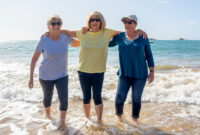Senior travel trips offer a unique opportunity for exploration and relaxation, allowing older adults to experience new cultures, breathtaking landscapes, and unforgettable moments. This guide delves into the exciting world of senior travel, covering everything from choosing the perfect destination and trip type to budgeting, health considerations, and accessible activities. Whether you dream of a relaxing cruise, an adventurous escorted tour, or an independent exploration, we’ll equip you with the knowledge and resources to plan a safe, comfortable, and enriching journey.
We’ll explore popular destinations, discuss various trip types, and provide practical tips for planning, budgeting, and ensuring a healthy and enjoyable travel experience. We also address important considerations like accessible transportation and senior-friendly activities, ensuring your trip is tailored to your needs and preferences. Prepare to discover the boundless possibilities that await you on your next senior travel adventure.
Types of Senior Travel Trips
Choosing the right travel experience is crucial for a fulfilling and enjoyable senior trip. The ideal trip depends on individual preferences, mobility, and desired level of activity. Several options cater to diverse interests and needs, ensuring a memorable adventure for every senior traveler.
Cruises
Cruises offer a convenient and relaxing way to explore multiple destinations without the hassle of frequent packing and unpacking. A typical itinerary might involve visiting several ports of call over a week or more, with each stop offering shore excursions tailored to different interests, from historical sightseeing to cultural immersion. Activities onboard often include fine dining, live entertainment, swimming pools, and spa services.
- Pros: All-inclusive packages simplify budgeting, convenient travel between destinations, numerous onboard activities, varied shore excursion options.
- Cons: Can be expensive, potential for seasickness, limited independent exploration at ports, crowded environments.
Escorted Tours
Escorted tours provide a structured and worry-free travel experience, with a tour guide handling logistics, transportation, and accommodations. A typical itinerary might include guided visits to historical sites, museums, and local markets, combined with comfortable hotel stays and pre-arranged transportation. Activities may vary based on the tour’s theme and destination, ranging from walking tours to cooking classes.
- Pros: Convenient and organized travel, expert guidance, opportunities for social interaction, pre-arranged accommodations and transportation.
- Cons: Less flexibility and spontaneity, potential for rushed itineraries, may not cater to individual preferences, can be expensive.
Adventure Travel
Adventure travel for seniors often focuses on low-impact activities that allow for exploration and engagement with nature while prioritizing safety and comfort. A typical itinerary might involve gentle hiking, wildlife viewing, or kayaking in scenic locations, with accommodations in comfortable lodges or eco-friendly resorts. Activities may include guided nature walks, bird watching tours, or visits to national parks.
- Pros: Engaging and stimulating experiences, opportunities for physical activity and fresh air, connection with nature, potential for personal growth.
- Cons: Requires a certain level of physical fitness, potential for challenging terrain, weather-dependent activities, may involve longer travel times to remote locations.
River Cruises
River cruises offer a more intimate and relaxed travel experience compared to ocean cruises, often focusing on exploring a specific region or waterway. A typical itinerary might involve navigating picturesque rivers, visiting charming towns and villages, and enjoying onboard amenities such as fine dining and comfortable staterooms. Activities may include cycling excursions, guided walking tours, or wine tastings.
- Pros: Relaxed pace, intimate atmosphere, opportunities for exploring smaller towns and villages, scenic views.
- Cons: Limited destinations compared to ocean cruises, potential for less varied activities, may be less suitable for those with mobility issues.
Rail Tours
Rail tours provide a scenic and comfortable way to travel, offering stunning views and a relaxed pace. A typical itinerary might involve journeys through picturesque landscapes, with stops at historical sites and charming towns along the route. Activities may include guided tours, visits to local markets, and opportunities to enjoy the onboard amenities.
- Pros: Scenic views, comfortable travel, convenient and relaxing, opportunities to explore multiple destinations.
- Cons: Limited flexibility, potential for delays, may not be suitable for those with mobility issues, can be expensive.
Health & Safety Considerations for Senior Travelers
Planning a senior travel adventure requires careful consideration of health and safety. Prioritizing well-being ensures a smooth and enjoyable trip, allowing you to fully appreciate your chosen destination. This section will outline essential preparations and precautions to maximize your safety and minimize potential risks.
Travel Insurance and Medical Considerations
Comprehensive travel insurance is paramount for senior travelers. It provides financial protection against unexpected medical emergencies, trip cancellations, and lost luggage. Policies should ideally cover emergency medical evacuation, hospitalization costs, and repatriation to your home country. Before purchasing, carefully review the policy’s terms and conditions, ensuring adequate coverage for your specific needs and pre-existing medical conditions. It’s also crucial to consult your physician before traveling, discussing any necessary vaccinations, medications, and potential health concerns related to your destination. Carrying a detailed medical history, including a list of current medications and allergies, is essential in case of emergency.
Staying Healthy and Safe While Traveling
Maintaining health and safety while traveling involves proactive measures. Packing essentials like a well-stocked first-aid kit, comfortable walking shoes, and any necessary prescription medications is crucial. Staying hydrated by drinking plenty of water, especially in warmer climates, is vital. Sensible sun protection, including sunscreen, a hat, and sunglasses, is also important to prevent sunburn and heatstroke. Furthermore, being mindful of food safety and hygiene practices, such as washing hands frequently and avoiding uncooked or undercooked food, helps to minimize the risk of foodborne illnesses. Familiarizing yourself with local emergency services and contact information is another key safety precaution.
Potential Health Risks Associated with Different Travel Destinations
Different travel destinations present varying health risks. For example, tropical regions may pose a higher risk of mosquito-borne illnesses like malaria or dengue fever, necessitating appropriate preventative measures such as insect repellent and antimalarial medication (if prescribed by a doctor). Areas with poor sanitation may increase the risk of gastrointestinal illnesses. High-altitude destinations can cause altitude sickness, requiring acclimatization periods and potentially medication. Researching specific health risks associated with your chosen destination and taking necessary precautions is crucial. This could involve consulting a travel clinic or doctor specializing in travel medicine to discuss recommended vaccinations and other preventative measures. For instance, if traveling to a region with a high prevalence of Zika virus, taking precautions to avoid mosquito bites would be essential.
Accessible Activities and Attractions for Seniors
Planning a trip that caters to the needs and preferences of senior travelers requires careful consideration of accessibility. Many destinations offer a range of activities and attractions designed to accommodate varying mobility levels, ensuring a comfortable and enjoyable experience for everyone. This section highlights examples of accessible options and potential limitations.
Accessible Activities in Various Locations
Choosing activities that suit individual mobility levels is crucial. Consider these examples:
- Whale Watching Tours (Moderate Accessibility): Many whale watching tours offer accessible boarding and viewing areas. However, the stability of the boat during the trip may be a factor for those with balance issues. It’s essential to check with the tour operator beforehand about specific accessibility features and any potential sea-sickness considerations.
- Botanical Gardens and Parks (High Accessibility): Many botanical gardens and national parks feature paved pathways, accessible restrooms, and well-maintained grounds. However, some areas might have inclines or uneven terrain. Check the garden or park’s website for accessibility maps and details before your visit. For instance, the New York Botanical Garden offers wheelchair rentals and accessible trams.
- Museums and Art Galleries (High Accessibility): Most major museums and art galleries prioritize accessibility, providing ramps, elevators, wheelchair rentals, and audio guides. However, navigating crowded spaces can be challenging. Checking the institution’s website for accessibility information, including details on elevator availability and the width of doorways, is recommended.
- Scenic Train Rides (High Accessibility): Scenic train rides, especially those designed for tourism, often have accessible carriages with wide doorways and accessible restrooms. However, some older train lines may have limited accessibility. Always confirm accessibility features directly with the train company.
Visual Representation: Accessible Attractions in Quebec City
Imagine a vibrant infographic depicting accessible attractions in Quebec City, a popular destination for senior travelers. The infographic is divided into three sections.
The first section features a map of Old Quebec, highlighting key accessible sites with icons. These icons include a wheelchair symbol for wheelchair accessibility, a walking stick for easy walking routes, and a magnifying glass for accessible information and audio guides. Specific landmarks such as the Citadelle of Quebec (with a note about accessible pathways and elevators), the Plains of Abraham (showing wide, paved pathways), and the Musée de la civilisation (with a note indicating wheelchair accessibility and accessible restrooms) are clearly marked.
The second section showcases photographs of accessible features. One photo depicts a wide, ramped entrance to a historical building. Another shows a well-maintained, paved pathway winding through a park. A third photograph shows a sign with clear, large font indicating accessible restroom locations.
The third section presents a list of accessible transportation options, including accessible taxis and the city’s public bus system. It also includes contact information for local accessibility services. The entire infographic is designed with clear, easy-to-read fonts and a color scheme that is visually appealing and accessible to those with visual impairments. The design emphasizes ease of navigation and clear visual communication.
Closing Summary
Planning a senior travel trip can be both exciting and daunting, but with careful consideration and the right resources, it can be an incredibly rewarding experience. From selecting the ideal destination and trip type to prioritizing health and safety, this guide has provided a comprehensive framework for crafting a memorable journey. Remember to prioritize comfort, accessibility, and personal preferences, ensuring your adventure is tailored to your unique needs and desires. Embrace the freedom of exploration, the joy of discovery, and the lasting memories that await you on your next unforgettable senior travel adventure. Bon voyage!




